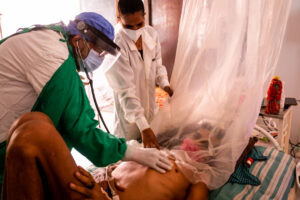Contemporary Issues
Results of Asian Press Photo 2022
GOLD
Harsha Vadlamani, India, Independent
In Chhattisgarh, one of India’s poorest states with a large indigenous population, only 40% of Primary Healthcare Centres have a medical officer. The country has an overall shortfall of 1.1 million doctors and 3.5 million nurses and midwives. India’s crumbling rural health infrastructure was not prepared for the pandemic. As all resources were diverted to fight the coronavirus, treating other diseases became a low priority. For instance, India accounts for 26% of the world’s tuberculosis cases, but reporting of new cases declined by 25-30% between January and June 2020. The lockdowns made it almost impossible for residents from remote villages to travel to the nearest town for healthcare. This project looks at how COVID-19 affected indigenous and rural populations in Maharashtra and Chhattisgarh, through the work of doctors working in low-resource settings at four non-profit hospitals operating in different settings. It examines the social and economic barriers that prevented the local populations from accessing healthcare during the pandemic and the role of quacks and faith healers in the local public health ecosystem. It also looks at vaccination drives, the role of fake news, and how the diagnosis and treatment of other illnesses took a backseat during the pandemic. The project was supported by a grant from National Geographic Society.
SILVER
Arie Basuki, Indonesia, merdeka.com
COVID-19 in Indonesia
BRONZE
Mouneb Taim, Syria, Freelancer
After ten years of the Syrian conflict, the Syrian regime forces have regained more than ninety percent of areas that had gone out of their control, and the city of Idlib in northern Syria remained the last trap of the opposition forces, the radical Islamist dates, in which more than four million Syrians live in refugee camps The Syrian government for the last battle and regaining the city that is under the control of the rebel forces, where many people live here. This project illustrates the struggle of civilians to bypass the war in the besieged region in northern Syria. Their lives are different. Every day there are air strikes and mutual bombing between government forces and the rebellion kills civilians, the routine will disappear The everyday is definitely unnatural, even if it seems normal to the people who live there. Every day, bombs fall, people die, and buildings will be destroyed. The truth of the war cannot be denied, however, there are people who are trying tremendously to resist the bitterness of this terrible war with their determination, hope and desire to live and with the support of the Russian forces, people in the southern countryside of Idlib were forced to leave the area after months of violent bombing operations that caused the deaths of thousands. And it led to massive destruction in the region. Today, more than four million Syrians live in a very small area, human shields are threatened with death on both sides, the militant forces that control their areas, the so-called Al-Nusra Front, and the Syrian government forces that are planning to regain the areas that have gone out of their control and are on the outskirts and borders The city of Idlib, after taking a large part of the rural areas and cutting off the M4 international road, but the people are struggling with life, violence and rebellion to live with its children in refugee camps, which increases its crisis. The coronavirus, which has become controlling a large part of them without



